Tackling Low Level Disruption in the Classroom
| ✅ Paper Type: Free Essay | ✅ Subject: Education |
| ✅ Wordcount: 4518 words | ✅ Published: 09 Jul 2018 |
- Hina Kamal Adham
Introduction:
It is a harsh fact that emerging numbers of children in the United Kingdom show disrupting, or expressing behaviour (also referred to as antisocial, challenging, defiant, noncompliant, aggressive, and acting-out behaviour), beyond the infrequent negligible incidents typical of most children throughout the usual progression of their development. Such behaviour has become one of the most unyielding concerns in schools (Bullock, Reilly, & Donahue, 1983; Evans & Evans, 1985; Hranitz & Eddowes, 1990).There are implications when schools fail to prepare for behaviour disorders in secondary schools. Emotional behaviour disorder, aggression, defiance and disruption are most common reasons why students don’t do well in school. ‘One of the biggest challenges facing the classroom today is the on-going need to address problem behaviour’ (Calvin, 2010), according to Cowley(2001) one of the most essential characteristics of a good teacher is the ability to manage good behaviour, so that effective learning takes place . This vital aspiration can be generated of learning, if we can get children to focus, to have self-discipline, to behave themselves. In this essay I will discuss low level disruptions (LLD) as classified by Capel (2009) . ‘What are the most effective strategies for combatting low level disruption?’
The YouGov investigations indicate that pupils are theoretically behind up to an hour of education every day in English schools because of this kind of distraction in classrooms. This is comparable to 38 days of learning lost each year. An enormous number of pupils, therefore, are being denied a major amount of valuable learning time. Typical features of this type of behaviour comprise pupils: talking pointlessly or conversing; calling out without authorization; being sluggish to start work or track rules; presenting an absence of esteem for each other and staff; not bringing the correct apparatus; using mobile devices improperly (Ofsted, 2014). According to Bennett (2011) this is ‘anything that slows down the flow of your lesson without actually blowing it out of the water’.
School ‘X’ has a very strict behaviour policy and it is maintained throughout the school, and it was proved during observation of high sets classes that pupils were engaged and there were very minor behaviour problems. However, low level disruption was observed in year 9 bottom set class, which was mostly disrupted by three students and followed by other students. This bottom set class is doing Higher GCSE curriculum, which is very challenging for them and with this LLD in the class on constant basis, will not help them to learn and progress. Therefore, I decided to do my research on this class as it is very important to diffuse this LLD for better learning and teaching[M1]. The strategies I have decided to apply in this class are reminding routines and providing starters as soon as they enter the class, moving around the class and providing worksheets during lesson.
Research questions and sub questions:
- What are the most effective strategies for combatting low level disruption?’
- How can reminding the class routines and starter’s best be used to engage pupils?
- How worksheets can help to engage pupils?
- How moving around the classroom can help pupils to remain on task?
Focus:
The main focus of this essay will be observing low level disruptive behaviour occurring in classrooms and how this has effect on learning also on the teacher. In addition the importance of this observation is to discover the successful strategies that defuse LLD in classrooms and applying to my own teaching and observe how effective those strategies are during my lesson which can be shared to make future decisions based on data collected during this research. A case study will be formed to examine the approaches I can practise to reduce the level of LLD. This case study will involve around using different strategies to diffuse LLD and see which method is most effective diffusing low level disruption. It is clearly shown that teachers use different ways of handling unacceptable behaviours therefore doing a case study at the ways they handle this to sustain good effective lesson will be done. Also, there will be different types of LLD behaviour which will be considered as well.
Information will be gathered by creating questionnaires and focus groups with the students. Observation will be based on year 9 set 4 who I will be teaching, to gather a combination of LLD behaviours that occurs. This will take place using each technique in each lesson so that defined data can be collected and then compared. Observations will be taken by same teacher to avoid biased data. This will be collected using a tally chart which will then be transferred to give pictorial demonstration as graphs and bar charts.
Research Plan
There are many different approaches that can be employed when collecting data. According to Walliman (2010) data is divided into two categories; qualitative and quantitative data. Qualitative data is grounded on understanding opinion of others, to describe a problem and develop into an approach. Qualitative depends on cautious description of the meaning of words, the progress of concepts and variables and plotting the relationships between these. Concepts such as People’s judgement, feeling of comfort, emotions, ideas, beliefs etc. can only be described in words. Common data collections used are in-depth interviews, focus groups, literary texts, historical records or observations. Qualitative data rely on human interpretation and evaluation and cannot be objectively measured in a typical way. Checks on consistency and extensiveness of qualitative data can be completed by referring a range of source of data relating to same event, called as triangulation (Walliman, 2010). It is the ‘insights rather than statistical perceptions of the world’ (Bell, 2005).
Quantitative research can be measured more precisely because it comprises some form of extent, usually expressed in numbers. Mathematical procedures can be used to analyse the data (Walliman, 2010) and according to Bell (2005) can be used to ‘study the relationship of one set of facts with another’. These can be mostly simple such as amounts or percentages or further sophisticated, such as statistical trials or scientific models. Examples of this type of collection are surveys and questionnaires (Walliman,2010).
My analysis will be centred on using qualitative and quantitative methodology in order to observe and accumulate data to produce effective conclusion. The investigation will be carried out through the school that I am currently in to observe and gather data for producing the outcomes.
The predominant methodology in this research is a blend of case study and action research. Case study surpasses at taking us to knowledge of an intricate matter or object and can spread understanding or add strength to what is previously known through former research.
This research is also based on action research, as it is an experiment that if the desirable approach when applied shows any outcome. Action research should be reflected as a way of life in the classroom. As an insightful specialist it can be observed what occurs in the class and then classify a problem that needs to be addressed (Brown, 2015). The key features of action research comprise its combined nature, its open approach to power and teaching in the research practice, and its importance on taking action on a matter. The widespread cooperation between investigators and associates in action research must spread through each phase of investigation, from recognizing the problem to propagating the outcomes (BMJ, 2008). If the conclusions show a change in behaviour in-favour of the research question there is the possibility of offending the current practice of other teachers (Bell and Waters, 2014)
Case study will provide useful insightful information about Low level disruption and why it occurs bearing in mind three probable features that may subsidise; beginning of the lesson with class routines reminded and starters; using worksheets in middle of lesson; moving around the class to help students to stay on task. Case studies are advantageous when considering directly at cause and result especially when the investigator has partial control of events that occur during a study (Cohen, Manion and Morrison, 2011). After consulting relevant literature, I will then formulate an approach or intervention, which I will carry out in my classroom. Therefore, I will use action research and work with this intervention and I will reflect and reconsider its effectiveness and impact and the cycle can start again. For a practice-based investigation I may go through several sets or complete one set only. The advantage of the action research is that it naturally develops from your teaching practice and that it addresses real issues within your classroom. Typical criticism of action researches would be that they are not rigorous or systematic enough. I aim to produce better learning and reduce LLD, based on initial observations by manipulating pupil’s experiences such as getting on with starter, using worksheets to engage them, moving around the class so that stay on task.
To avoid biased results, Mr A will be observing the lesson. The data will be taken in form of tally table where different types of LLD behaviour will be monitored and noted. The different types of LLD include taking, calling out, slow at working, not bringing the right equipment, taping, throwing objects, walking across the room, using mobile devices, giggling or laughing. The data collected during different lessons using different strategies to control LLD, for example data collected when teacher is moving around the class and when teacher is not moving around the class, from this examination it will then be converted into graphical demonstration, analysed and further evaluated and compared to be able to answer the difference that how these strategies are combatting LLD. Although observations can provide you vast amount of data, but many errors can occur during observations, one of the main error can occur due to the presence of observer, students can act differently or observer can be biased, therefore despite the many advantages of the case study procedure, it has limitation mainly due to subjectivity by the researcher therefore I will need to bear in mind this when carrying out the results.
Along with the case study, questionnaires will be produced for students to answer. Using this method, I will be able to gather data from their viewpoint on how well they think teacher manages the class especially when LLD behaviours are prompted. This is also to know their point of view that how they feel when these techniques are used in class to diffuse LLD. Questionnaires permits data to be congregated into numerical arrangement as the questions are more inflexible as the respondent can only select from customised set of answers you have given. This procedure is a fast way to gather data and more unbiased; it’s easy to analyse and they are quick for respondent to answer. However, there are some disadvantages for instance, if people are not interested in the topic they will respond skewing the sample, or they will ignore some questions. When formulating the questions, it is significant to plan them to help answer the research question in mind. Focus group will be generated for the students. Focus groups also called as group discussions an effective and reliable technique for accumulating data. The focussed groups will be used to ask the students questions regarding their own perceptions of LLD, what do they think of strategies used to diffuse LLD, how often LLD occurs in their classroom also how well they think the strategies used can help to concentrate more and do well during lesson. Focus groups are advantageous as it delivers rich information that can ‘highlight issues not previously considered’ as Wilson (2009) claimed. Therefore, using questionnaires and focus groups it will verify the data collected during observation[M2].
Ethical Considerations
It is important to consider ethical consideration, when a research is performed and it requires involvement of people. The ethical considerations implemented are the framework formed by Cohen, Manion and Morrisons (2004). It is ensured in this research that there is enough data to draw into conclusions with evidence. There is no name and identity revealed in this research, which is very important. The purpose and procedures of research have been informed to the teachers and the students, providing them with full details that what is being looked into. Concern was made into how the research would be beneficial for school rather than being risky as all ethical characteristics have been reflected. Additionally the investigation can be favourable to teachers with respect to how to handle LLD in classrooms. Any debatable concerns that may arise will be measured with great thoughtfulness as the research will be unbiased as possible. Every teacher handles LLD using their own strategies, hence it is expected some will vary to control and disregard this. Everything will be kept anonymous to avoid insecurity from teachers on their ability of handling LLD. The way this research has been designed and will conduct, very careful though has been taken into account, to keep it as objective as possible[M3].
Outcomes:
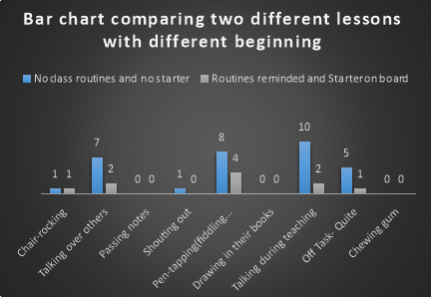
Figure (1) shows the bar chart of two different lessons of same class started differently, blue bar shows the data collected when class routines were not reminded to class before entering the class and no starter on board, grey bars shows the data collected when students were reminded of class routines and starter was already on board. The systematic observation results are quite evident, and show the relation between the beginnings of two lessons. When no routines were reminded and no starter was on board they were less prepared, they didn’t take out books and equipment’s straight away as they entered the class, they lost concentration and were not ready to learn, therefore low level disruption was triggered straight away as there was no structure in place as compared to the results when students were reminded of clear routines as soon as they entered the class and starter was already on board for them to get started with work.

Figure (2) shows the graphical representation of questionnaire results from students during the lesson when no routines were reminded to them while entering the class and no starter was on the board. 21.6% students agreed and strongly agreed that they learned a lot in the lesson, they felt challenged in the lesson, and they worked well in the lesson, however 32% disagreed and strongly disagreed with the above statements. 30% students agreed that they felt distracted during lesson and only 25% students disagreed. 20% of students manage to finish work.

Figure (3) shows the graphical representation of the results of questionnaire completed by students. The bar chart shows that 35% of students agreed and strongly agreed that they learned a lot in that lesson, felt challenged and worked well in the lesson and 18% students disagreed with the statements. 12.5% students agreed and 37.5% disagreed that they got distracted in the lesson. Hence if the two results of figure 2 and 3 are analysed and compared, it can be seen clearly how effective reminding routines and displaying starter at the beginning of the class, if the starter is already on the board for students it challenges students energy.
Lastly during focussed groups, students answered about how they feel when routines were reminded, their answers matched to the data collected through observations and questionnaires, they felt reminded that they are in the class and they should be ready to do work, similarly they thought when the starter is not on the board they don’t feel challenged and focussed as they don’t know exactly what to do.

Figure (4) shows the mathematical representation of two sets of data collected in two different lessons of same class, blue bars shows the data collected when there was no movement in the class and teacher stood by the board while students were given a task. The systematic data is very clear and shows the difference that how LLD changes when teacher is moving around the class, which show how teacher’s presence is influential. If teachers remain still at the front of class students can easily get distracted and it can be seen from the bar chart that many students were talking and were off-task. When teachers move around and talk to students about their task, it helps them to remain on task and focussed.
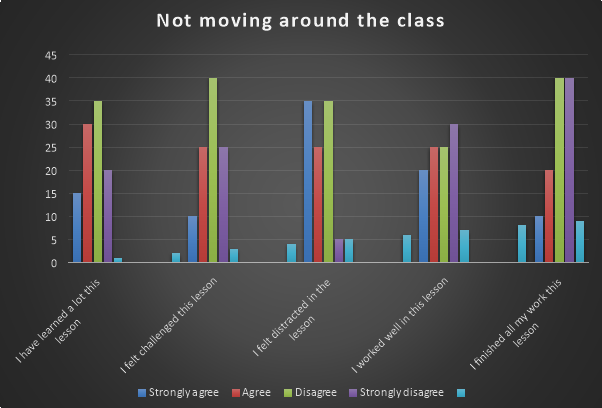
Figure (5) shows the graphical representation of the results of questionnaire from students during the lesson when teacher was not moving around the class and was standing at front of the class. 21% of students felt they learned a lot, they felt challenged and they worked well during the lesson. 30% of students felt distracted and 20% disagreed that they felt distracted during lesson. Only 15% of students finished all work and 40% disagreed that they managed to finish their work.
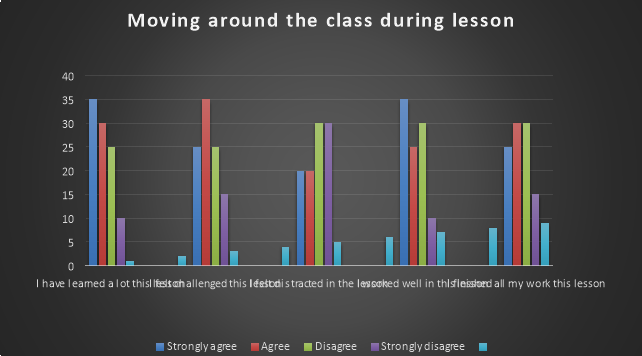
Figure (6) shows the graphical representation of questionnaire results during the lesson when teacher was moving around the class to check students work and to help them. 31% students agreed and strongly agreed that they learned a lot, they felt challenged and worked well during this lesson. 20% students felt distracted and 30% disagreed that they felt distracted. 28% students finished all their work and 22% students disagreed that they managed to finish their work during this lesson.
The outcomes between two situations can be compared and analysed, there is a difference of 10% of student’s better learning and less distraction when teacher was moving around the classroom and these results relate to observations taken in figure 4. It shows very clearly that when teacher moves around the classroom, students remain focussed and stay on task and ask questions, teachers spot common mistakes made by students and it helps teachers as well to assess them during this time. Hence it can be evaluated by focus group answers, when teacher is standing at front of the classroom, students don’t work and get a chance to talk to their peers, whereas when teacher is moving in the class, they feel focussed and try to get engaged, and added that sometimes they feel shy to ask questions and if the teacher is moving around, it’s easier for them to ask questions.
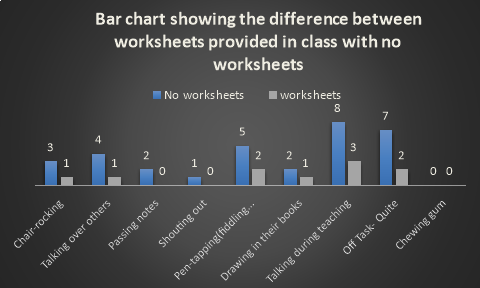
Figure (7) shows the mathematical representation of the data collected from two lessons of same class, blue bars shows the data when there were no worksheets used between the lesson and grey bars shows the data when worksheets are used in the lesson. It is evident that the LLD is much lower when worksheets are used in the class, especially for low set classes as they get distracted by looking at the board for a longer time, also it causes less anxiety for struggling students, and they feel successful repeating over and over again. When there are no worksheets, sometimes students find it boring and nothing different been done in the class[M4].
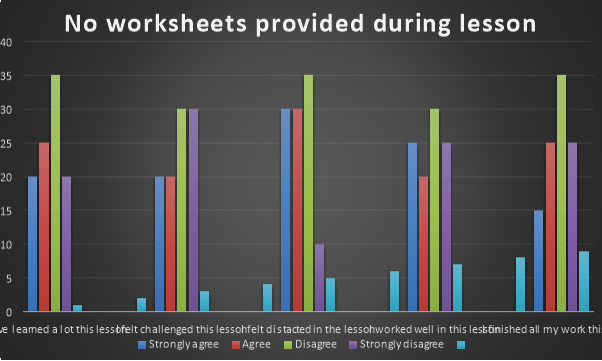
Figure (8) shows the results of the questionnaire requested by students to answer after lesson when “No worksheets were provided during lesson”. The data collected shows that 21.6% students strongly agreed and agreed that they learned a lot, felt challenged, and worked well this lesson; however 28.3% students disagreed and strongly disagreed about these statements. 30% students agreed and strongly agreed that they felt distracted this lesson and 22.5% disagreed and strongly disagreed. 20% students agreed that they finished their work and 30% disagreed that they finished their work.

Figure (9) shows the results of questionnaires from students when “worksheets were provided to students during the lesson”. The graphical representation shows clear results that students learned better when they were provided worksheets during lesson. 32.5% students strongly agreed and agreed that they learned a lot, they felt challenged and they worked well. 22.5% agreed that they felt distracted and 25% disagreed and strongly disagreed that they felt distracted. 30% of students agreed that they finished all their work and 20% students disagreed that they finished their work[M5].
The data between two different situations can be compared and it shows a clear result that only 21.6% students were concentrated during lesson when no worksheets were provided as compared to 32.5% students learned a lot during the lesson when the strategy was applied to diffuse LLD and worksheets were given to students, 22.5% students agreed that they felt distracted during that lesson as compared to 30% students who agreed that they felt distracted during lesson when there were no worksheets provided. This analysis shows that the strategy to diffuse LLD using worksheets is very effective and especially for lower ability sets who gets uninterested and disengaged by the middle of the lesson[M6].
Results of providing worksheets in the class can be triangulated by student’s focus group feedback, where they responded that it gets boring for them to see the board and copy questions from there, and they lose attentiveness, if worksheets are provided they feel focussed[M7].
Conclusion:
The first investigation carried out to diffuse LLD was reminding routines to the class and starter on board or ready for them to hand over, to conclude it is essential to point out the reality showed during a controlled and disciplined approach, shows from all three methodologies by observations(case study), questionnaires and focus group with a group of students that the LLD was massively reduced, as reminding routines fairly worked as it reminded students that they are in a learning environment, same as setting up the starter reduced all sort of LLD, students felt that they managed to [M8]do work well when they are given a direction as soon as they enter the class and they have work from previous lessons as starter, it keeps them enthusiastic about the lesson and focussed.
Similarly, second investigation carried out was “The effects on learning when teacher moves around the classroom”, the results drawn and analysed shows clear and positive outcome of this defined strategy that there was less LLD during the class, quantitative and qualitative both results conclude that it is an effective strategy whereas when the teacher was not moving during the lesson, students were disengaged and LLD was higher, students took advantage that teacher is not looking at their work so they can either talk or remain quiet and stay off-task. It was also proved while I was moving around and checking their books, students were trying to solve questions and focused as they knew teacher is present in the class and checking their progress[M9].
Third investigation carried out was “How providing worksheets can help to reduce LLD”. At first observations and questionnaires were carried out when no worksheets were provided during lesson and questions were displayed on board, it was quite evident that they got disengaged and lost concentration copying questions from board, it can be the effect of seating of this class too as this class seating is they all sit in one columned desk and they find it difficult to look at the board for 60 minutes. Clear indications from observations, questionnaires result and lastly focus groups shows that student learn better if they receive a worksheet, as they are only focussed on the worksheet and not moving their head around and get distracted[M10].
The strategies applied to diffuse LLD shows clear results in improvement of behaviour, however for each strategy only one lesson was observed due to time constraint, which can give biased results, and students were informed that a research is taking place, and their behaviour could have been altered as defined by Hawthorne effect. Other than this human errors can occur while taking data and topic of lesson can affect these factors too as this is a lower ability class and doing higher GCSE, some topics are challenging and harder for the class to remain focus on. Therefore, the results are inconclusive, as there was no repetition of observations and the conditions of the class was not same throughout[M11].
Ways Forward:
This research has proved that to minimize or diffuse LLD in low ability classes:
- Students should be reminded routines of the class as they enter the class. Students can be anxious when they do not know what is going to happen during the day, students’ needs to be reminded and explained what are the expectations and what is going to happen during the lesson.
- Prepare starter and display on board or hand in to students as they enter the class, this is a basic one but it allows teachers to challenge student’s energy, setting out resources, finding papers and setting up the classroom while students wait only encourages LLD.
- Move around the classroom while students are given a task, teachers presence is extremely important and powerful. Moving around the class helps students to stay on task and not to get distracted. Talking to them about their task giving them deadlines can help to reduce LLD.
- Provide worksheets for the lesson, as it helps especially lower ability groups to stay focussed, as students lose concentration easily copying questions from board and lesson becomes boring for them, as moving around their head encourages to see around and talk to their peers rather than concentrating on the task.
As discussed in conclusion, to draw more reliable and successful understanding of this research, further investigations have to be supported in the following way.
Each strategy used to minimise LLD, would have to be repeated, so that more accurate and wide data can be drawn, so that the degree of accuracy is higher. Students will not act or be conscious about the research and will be more comfortable in the research environment. This study should take place on a wider range and research should be carried out with different year groups and different abilities. Recording a lesson is another way to make data more reliable, as there will be no biased results or human errors involved.
The following research can help other teachers and the school, in order to maintain better learning of pupils and minimising LLD[M12].
References:
- Bullock, L., Rielly, T., & Donahue, C. (1983), School violence and what teachers can do about it. Contemporary Education,55(1), 40-43.
- Colvin, G. (2010) Defusing Disruptive Behaviour in the Classroom, California: SAGE
- Cowley, S. 2001, Getting the buggers to behave, Continuum, London.
- Capel, Leask and Turner. (2001). Learning and Teaching in the Secondary School. A companion to School Experience. London. RoutledgeFalmer.
- Ofsted(2014) Below the radar: low-level disruption in the country’s classrooms ,[Online], Available: https://www.gov.uk/government/uploads/system/uploads/attachment_data/file/379249/Below_20the_20radar_20-_20low-level_20disruption_20in_20the_20country_E2_80_99s_20classrooms.pdf [september,2014]
- Bennett, T. (2011) Behaviour – Low Level Disruption, [online], Available: http://www.tes.co.uk/article.aspx?storyCode=6087267 [19/12/2013]
- Walliman, Nicholas. The Basics : Research Methods: The Basics : The Basics (1). Florence, US: Routledge, 2010. ProQuest ebrary. Web. 12 November 2016.
- Brown, Nicole. (2015)Action research or Case study.[Online],Available: http://www.nicole-brown.co.uk/action-research-or-case-study/
- BMJ 2008;337:a567
- Bell, J. and Waters, S. (2014). Doing Your Research Project. 6th ed. England: McGraw Hill Education
- Cohen, L. Manion, L. and Morrison, K. (2011). Research Methods In Education. 7th ed. London: Routledge.
- Lawrence, T(2013). 10 ways to deal with Low Level distruption,[online], Available: https://www.theguardian.com/teacher-network/teacher-blog/2013/may/21/classroom-disruption-top-tips
[M1]Good to see that you have used sources and you build a good context. This is sufficient but EBI you have focused on some detail here on particular strategies. (i.e. given that ‘starters’ is a strategy you look at could you have used the lecture where ‘start the lesson before the lesson’ was considered?)
[M2]Good, this part is sourced well, you understand some important methodology concepts and have built a reasonably clear plan.
<
Cite This Work
To export a reference to this article please select a referencing stye below:
Related Services
View allDMCA / Removal Request
If you are the original writer of this essay and no longer wish to have your work published on UKEssays.com then please click the following link to email our support team:
Request essay removal


